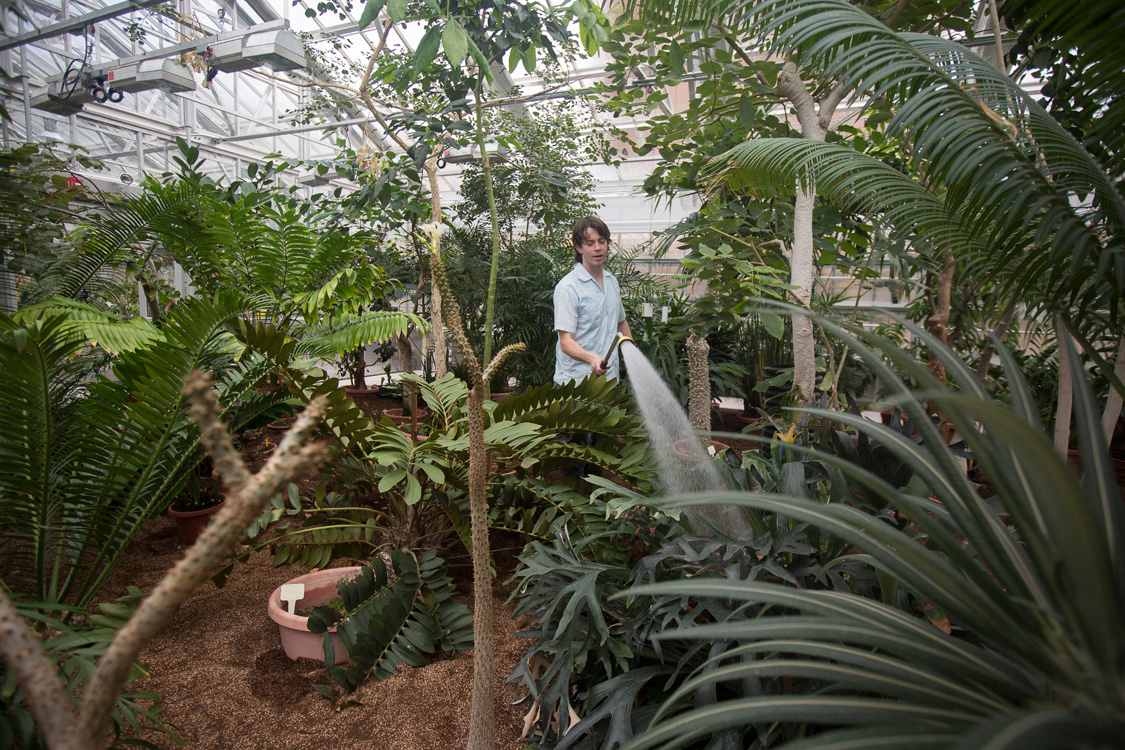After six years, Liberty Hyde Bailey Conservatory reopens
By Matt Hayes

The rebuilt Liberty Hyde Bailey Conservatory Greenhouse opens Feb. 9 as Cornell continues the botanical legacy of engagement and discovery established by the first dean of the College of Agriculture and Life Sciences.
The 4,000-square-foot facility at 236 Tower Road features modern equipment designed for increased energy savings and improved plant growth. But the spirit of the conservatory remains fixed on the ideals of education and outreach, says Professor Karl Niklas.
“The collection is a living archive describing the wondrous diversity of plant life,” says Niklas, the Liberty Hyde Bailey Professor of Botany. “Generations of Cornell students have relied on the conservatory to bolster their knowledge. The conservatory also provides students, staff and faculty with a green oasis in which to seek solace during the winter months. It promises to extend these important intellectual and emotional functions for many more years to come.”
Housing more than 500 species from nearly 80 different families, the greenhouse maintains an indoor climate ideal for plants native to tropical, subtropical and other regions, including two of the university’s famed corpse flowers. The conservatory, managed by the Cornell University Agricultural Experiment Station, contains one of several plant collections that make up the Liberty Hyde Bailey Hortorium in the Plant Biology Section of the School of Integrative Plant Science.
Established in 1931 by the famed American horticulturist who lends the conservatory his name, the greenhouse began as a research center focused on palm species. For 79 years the conservatory grew in scope while providing Cornell plant biologists access to diverse plant life from around the world. The wood-framed structure built by the Lord & Burnham Co. closed in 2010 when it reached the end of its useable life.
The conservatory’s two sections
Closest to the Plant Science Building, the Student House features potted plants arranged on benches. Plants in this section – orchids, cacti, euphorbs, grasses and an array of primitive and unusual plants – are used mainly for teaching and some research.
The Palm House section fronting Tower Road features a single, large bed bounded by a walkway. Named in honor of Liberty Hyde Bailey’s specialty, the Palm House holds bird-of-paradise, a titan arum, a number of cycads and species of ethnobotanical interest like cocoa and coffee plants in a bed filled with a growing medium made of a custom mix of coconut coir, biochar and clay-based products.
The new building is split into two sections and located on an expanded footprint adjacent to the Plant Science Building. Inside, the conservatory houses a diversity of plants Bailey himself would know well that are nurtured with a technical sophistication surpassing anything available in his time.
With cutting-edge monitoring technology and automated equipment, the conservatory brings 21st-century precision to botanical study, according to plant growth facilities manager Andy Leed.
“The new conservatory is much brighter and has far better environmental control, both of which will improve the health and growth rate of the plants in the collection,” Leed says. “We can see that improved growth already.”
Computerized environmental controls detect minute changes in growing conditions as sensors measure light, humidity and temperature, and respond automatically to changing conditions. Features of the greenhouse include larger vents to give improved air circulation without loud, motorized fans; a hot water system replacing steam to afford better temperature control and energy savings; and a state-of-the-art fog system for humidification and evaporative cooling throughout the building.
One of the most impressive features, according to the conservatory’s head grower Paul Cooper, is a mechanical shade and insulating system that gives precise control of light intensity while providing a secondary layer for energy retention. At dusk, the retractable curtains on the understory of the facility close to trap the heat; during the day, the system automatically responds to light intensity.
The automatic shade curtain reduces heat loss by up to 40 percent, according to Leed. He estimates the entire system uses 50 percent less heating energy than older greenhouses, savings that lower costs and improve sustainability across the growing operation.
Liberty Hyde Bailey Conservatory is open to the public. Hours and other information can be found at conservatory.cals.cornell.edu.
Matt Hayes is managing editor and social media manager for the College of Agriculture and Life Sciences.
Media Contact
Get Cornell news delivered right to your inbox.
Subscribe